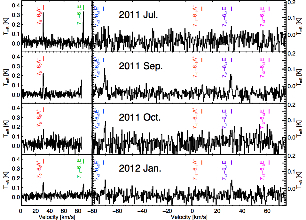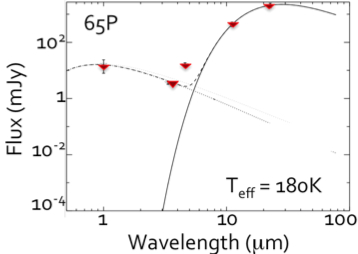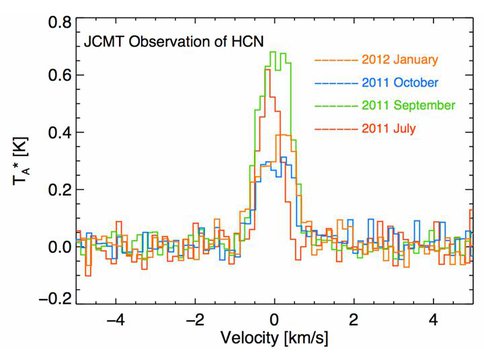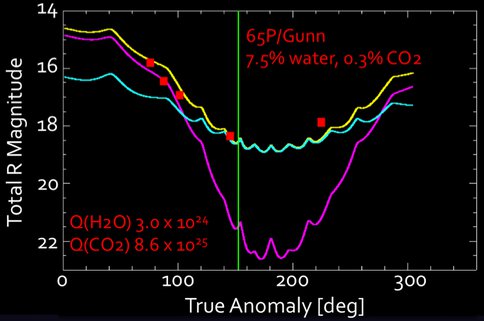2012 Annual Science Report
 University of Hawaii, Manoa
Reporting | SEP 2011 – AUG 2012
University of Hawaii, Manoa
Reporting | SEP 2011 – AUG 2012
The Chemical Composition of Comets
Project Summary
Understanding the origin and the distribution of organic matter and volatile material in the early Solar System is of central importance to astrobiology. Comets, which have escaped the high-temperature melting and differentiation that asteroids experience, are “astrobiological time cap-sules” that have preserved a valuable record of the complex chemical and physical environment in the early solar nebula. Studying the primordial chemistry and evolution of cometary nuclei will pro-vide important clues about the birthplace of comets and in turn place strong constraints on the cur-rent Solar System formation models. In late 2011 and 2012, two bright comets, C/2011 L4 (Pan-STARRS) and C/2009 P1 (Garradd), visited the inner Solar System for the first time. In March 2012, C/2011 L4 (PanSTARRS) is expected to appear even brighter than the comet Hale-Bopp, the bright-est since 1996. We have recently studied C/2011 L4 and C/2009 P1 in the sub-millimeter and infra-red wavelength regimes using the James Clerk Maxwell Telescope (JCMT), Caltech Submillimeter Observatory (CSO), Gemini-North and the Keck Telescopes on Mauna Kea, Hawaii. We investigated the chemical compositions of these comets and compared them with those of other comets. Our unique observations of these two bright comets over a wide range of heliocentric distances allow monitoring of the abundances of several native molecules that are key to understanding comet formation.
We are also conducting a systematic survey of comet brightness around their orbits in order to model their volatile composition. Using space-based data from the Akari Satellite, the WISE Satel-lite, and the EPOXI mission we are showing that these models can provide information on gas spe-cies normally not detectable through Earth’s atmosphere. This gives us the opportunity to investi-gate the wide spread distribution of key cometary volatiles (water, carbon monoxide and carbon dioxide) and their relation to protoplanetary disk chemistry.
Project Progress
It has been suggested that icy bodies in the two main cometary reservoirs (Kuiper Belt (KB), Oort Cloud (OC)) formed in different regions of the proto-planetary disk. Whether the two families of comets have the same chemical composition has important implications for the amount of radial mixing in the proto-planetary disk. Fundamental clues to natal conditions can be provided by meas-uring native molecule abundances within an individual comet, and by building a comet classification or taxonomy through compositional comparisons among comets from different populations. Come-tary composition is usually derived from observations of volatile species (known as parent mole-cules), e.g., HCN, CH3OH, CO, and CS2, in the cometary comae that sublimate directly from the nu-clei. Likewise, thermal models can be used to predict the comet brightness as a function of helio-centric distance and infer the presence of major volatiles (H2O, CO and CO2) since they sublimate at very different temperatures.
5.1.3.1 – Radio Observations
Compared to other direct measurement techniques, radio spectroscopy offers two major ad-vantages, namely the pure rotational transition mechanism and high spectral resolution that cannot be achieved in other wavelength regimes. Using these techniques, we observed the comet C/2009 P1 Garradd in four observing runs between July 2011 and January 2012, covering the heliocentric distance ranging from 2.49 AU to 1.56 AU. Three parent volatiles, namely HCN, CH3OH, and CO, as well as CS – originating from the short-lived CS2 – were observed in comet Garradd before and after its perihelion. We monitored HCN J(4-3) line frequently to search for sporadic outbursts and rota-tional modulation. Although no short-term variability of spectral lines was observed on an hourly basis, the strength and the line shape of HCN varied with heliocentric and geocentric distances. Ro-tational temperature was measured from simultaneous observations of several CH3OH lines, follow-ing the standard rotational diagram technique. Our observations show that CO in comet C/2009 is somewhat enriched, consistent with the observations in the infrared. The relative abundances of HCN, CH3OH, and CS of comet C/2009 are typical for other Oort Cloud comets.
The sub-millimeter observation of comet C/2011 L4 was first made in April 2012, when the comet was 5 AU from the Sun, using the CSO telescope. We searched for HCN and CO in the sub-millimeter spectra of the comet. The CSO observation showed that the coma of C/2011 L4 mostly consists of cometary dust. No gas emission was detected. The second observation of C/2011 L4 was made in August 2012, when the comet was 3.6 AU from the Sun, using the JCMT telescope. No HCN or CO lines were observed in August. The infrared observations of C/2011 L4 using the Gemini-North tele-scope detected strong water ice absorption features. The sub-millimeter and infrared observations indicate that the comet’s ice sublimation rate remains weak when the comet is beyond 3 AU from the Sun. These observations are consistent with observations of other comets at similar heliocentric distances.
5.1.3.1 – Near Infrared Spectra
In a collaboration lead by the Goddard NAI lead team, we also obtained high-resolution near IR spectra of comet C/2009 P1 Garradd using the Keck II telescope both pre- and post-perihelion to assess the relative abundances of primary parent volatiles and compare them to other Oort Cloud comets. Our group found that CO was enriched, some parent organic volatiles were depleted, and others were at levels typical of other Oort cloud comets. These abundances may indicate surface oxidation on pre-cometary grains in addition to reduction reactions. The overall gas production was lower post-perihelion.
5.1.3.1 – Optical Imaging and Thermal Sublimation Models
Comet missions are changing the paradigm for understanding comet activity, composition, and the formation of planetesimals in the protoplanetary disk. Each encounter has shown the diversity of surface morphologies and new insights into comet chemistry, formation scenarios, activity mecha-nisms and geology. Prior to the comet 103P/Hartley 2 EPOXI encounter, the prevailing view was that H2O-ice sublimation controlled most comet activity. Differences in the amounts of minor par-ent/daughter photo-dissociation species are attributed to differences in formation location, tem-perature and disk chemistry. However, reconstructing the protoplanetary disk dynamics and chem-istry consistent with observations hasn’t yet been achieved.
The EPOXI mission flew past the nucleus of comet 103P/Hartley 2 on 11/4/2010. This small nu-cleus was known to be exceptionally active prior to the encounter, by virtue of a very large water production rate relative to its surface area. EPOXI provided stunning images of a small nucleus with strong chemical heterogeneity and a swarm of large icy chunks driven from the nucleus by CO2 jets. The EPOXI ground-based campaign provided a long-term baseline of observations of the pre-perihelion brightening of the comet which also showed that comet Hartley 2’s perihelion activity was dominated by sub-surface CO2 outgassing.
Because the Earth’s atmosphere is opaque at the wavelengths for CO2 emission, there is only a little information about CO2 abundance in comets (primarily from space missions), yet CO, CO2 and H2O are likely key tracers of the chemistry in the protoplanetary disk. EPOXI has shown the crucial role that CO2 plays in comet activity. We have now been applying thermal sublimation models to comets with well-observed light curves and for which we can get information about CO2 production from the Akari and WISE missions. We now have the tools to explore the three most abundant vol-atile species (H2O, CO and CO2) in a large number of comets. This will be a necessary key compo-nent to understanding the connection between today’s observables, future resolved protoplanetary disk chemical observations, and chemical / dynamical models of disk formation.
The JCMT observation of HCN J(4 3) line of comet C/2009 P1. Observations made in Jul. (r=2.49, Δ=1.58 AU), Sep. (r=1.97, Δ=1.62 AU), Oct. (r=1.76, Δ=1.95 AU) and Jan. (r=1.56, Δ=1.86 AU) are shown as red, green, blue and orange, respectively. It shows that the profile and strength of the HCN line varies with respect to different heliocentric and geocentric distances.

CH3OH averaged spectra of comet C/2009 P1, taken in Jul., Sep., and Oct. 2011 and Jan. 2012. Colored labels indicate detected CH3OH spectral lines between levels with quan-tum numbers J = 7 and J = 6.
Observations of comet Gunn as a function of position on orbit (red squares) compared to vola-tile sublimation models for water (pink), CO2 (cyan) and H2O + CO2 (yellow). The predicted CO2 outgas-sing rate matches the con-straints seen from the WISE observatory (next figure).

WISE infrared photometry of comet Gunn with fits for the scattered light and thermal emission. The excess at 4.2 microns is attributed to outgassing from CO2.
Publications
-
A’Hearn, M. F., Feaga, L. M., Keller, H. U., Kawakita, H., Hampton, D. L., Kissel, J., … Wellnitz, D. D. (2012). COMETARY VOLATILES AND THE ORIGIN OF COMETS. The Astrophysical Journal, 758(1), 29. doi:10.1088/0004-637x/758/1/29
-
Yang, B., Lucey, P., & Glotch, T. (2013). Are large Trojan asteroids salty? An observational, theoretical, and experimental study. Icarus, 223(1), 359–366. doi:10.1016/j.icarus.2012.11.025
- Bauer, J.M., Stevenson, R., Kramer, E.A., Mainzer, A.K., Grav, T., Masiero, J.R., Fernandez, Y.R., Lisse, C.M., Meech, K.J. & Weissman, P.R. (2012). WISE/NEOWISE Comets: Nucleii and CO/CO2 Emission. Division for Planetary Sciences of the American Astronomical Society, 44.
- Meech, K.J., R., H.O., Bauer, J.M., Fernandez, Y. & Gulbis, A.A.S. (2012). Carbon Dioxide in Comets – 65P/Gunn and 74P/Smirnova-Chernykh. Division for Planetary Sciences of the American Astronomical Society, 44.
-
PROJECT INVESTIGATORS:
-
PROJECT MEMBERS:
Karen Meech
Project Investigator
Bin Yang
Project Investigator
James Bauer
Collaborator
Michael DiSanti
Collaborator
Michal Drahus
Collaborator
Yan Fernandez
Collaborator
Amanda Gulbis
Collaborator
Olivier Hainaut
Collaborator
Jacqueline Keane
Collaborator
Ekkehard Kuehrt
Collaborator
Stefano Mottola
Collaborator
Michael Mumma
Collaborator
Tobias Owen
Collaborator
Timm Riesen
Postdoc
Alain Khayat
Graduate Student
-
RELATED OBJECTIVES:
Objective 1.1
Formation and evolution of habitable planets.
Objective 2.2
Outer Solar System exploration
Objective 3.1
Sources of prebiotic materials and catalysts

